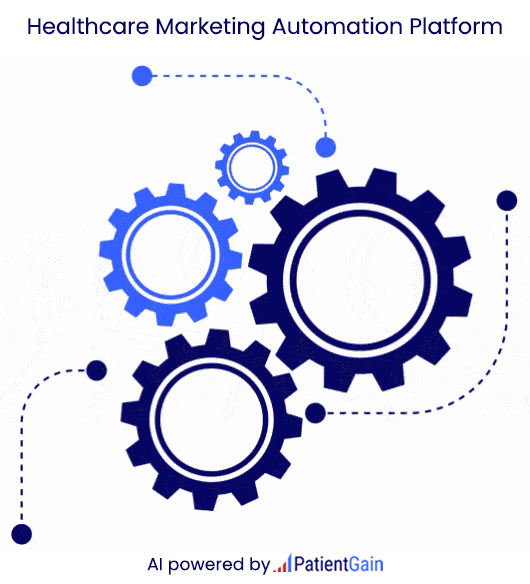Medical Marketing AI Agents Improve Your Return On Investment – Applies to Dental Marketing Also.
How AI-Based Software Agents Work in Healthcare Marketing: With Insights from PatientGain Platinum Service. AI agents are transforming medical marketing by offering a range of capabilities, from personalized patient interactions to automated content creation. They can handle tasks like answering patient questions, scheduling appointments, and even managing social media campaigns, freeing up human marketing staff to focus on strategic initiatives.

AI-based software agents like Gemini, ChatGPT, and xAI Grok utilize advanced natural language processing (NLP) and deep learning algorithms to interpret and generate human-like responses. When integrated into a healthcare setting, these AI systems can automate a variety of tasks, from handling patient queries to generating content that drives engagement. PatientGain’s Platinum Service uses similar technologies to enhance patient acquisition, engagement, and retention for medical practices.
PatientGain.com utilizes AI agents in their medical marketing platform
These AI agents are designed to help healthcare providers:
- Optimize patient acquisition, retention, and management.
- Improve operational efficiencies.
- Enhance patient interactions.
- Boost their practice’s growth.
Some of the ways PatientGain uses AI agents include:
- Automated communication, data analysis, and personalized marketing strategies.
- Chatbots, social media management, and online reputation management.
- AI-optimized social media content posts.
- Data analytics and dashboards for performance tracking.
- Automated tasks like managing online promotions and generating content.
- Enhancing patient engagement through tools like smart mobile messaging and chatbots.
PatientGain’s AI-based tools and services comply with HIPAA regulations.
In essence, PatientGain’s AI agents transform medical marketing by offering a range of capabilities from personalized patient interactions to automated content creation, freeing up human marketing staff to focus on strategic initiatives. They are typically powered by deep learning models that can understand context, generate human-like responses, and engage in dynamic conversations.
Artificial Intelligence (AI) based software agents like Gemini, ChatGPT, OpenAI, and xAI Grok work through machine learning and natural language processing (NLP) to interpret, generate, and respond to human language in meaningful ways. These systems can read websites, process content, and understand the structure of information to engage in conversations, perform tasks, or generate content. They also collect and “Assimilate” information from the top websites. For example if it is medical information, the agent may read FDA website and assimilate information and data available.
As a medical provider or a practice manager, you have to understand the changing technology and advancements in todays medical marketing. At the high level, basically there are 2 major AI agents. a) General regenerative agents ( like ChatGpt and Gemini) and b) Agentic AI agents.
Agentic AI
Agentic AI is a software application that is very specific to a certain task. They are referred to as AI systems that are designed to autonomously make decisions and act, with the ability to pursue complex goals with limited supervision. These agents typically will include
a) Work flows
b) AI based data
c) AI based decision making
d) human interaction
e) alerts
f) final outcomes
For example an AI agent developed by PatientGain for its internal use focuses on creating SEO content for increased rankings, based on reverse search engine algorithms. It uses work flows, AI based data, human interaction alerts (using Emails) and final outcome.
General AI Agents
OpenAI: This is the research and deployment company. Their flagship models are the GPT (Generative Pre-trained Transformer) series, such as GPT-3.5 (powering the free version of ChatGPT for a long time) and GPT-4, GPT-4o (powering ChatGPT Plus, Copilot, and available via API). They focus on creating powerful general-purpose models. ChatGPT: This is the conversational application (chatbot) built by OpenAI, using their GPT models as the engine. Its fine-tuning is heavily focused on dialogue capabilities.
Gemini (Google): This is Google’s latest family of multimodal models. A key aspect of Gemini is that it was designed from the ground up to be multimodal, meaning it can understand, operate across, and combine different types of information like text, code, images, audio, and video. It comes in different sizes (e.g., Nano, Pro, Ultra) for different applications.
xAI Grok: Developed by Elon Musk’s xAI, Grok is designed with a few differentiating features.
Key Differences Between These AI Agents
| Feature | Gemini | ChatGPT | xAI Grok |
|---|---|---|---|
| Creator | Google DeepMind | OpenAI | Elon Musk’s xAI |
| Primary Use | Multimodal (Text, Image, etc.) | Text-based conversations | Social media integration (X) |
| Integration | Google ecosystem, visual recognition | APIs, integrated into many services | Twitter/X platform |
| Strengths | Real-time context, advanced AI | Versatility, task-oriented, creative | Social media and real-time interactivity |
What is Prompt Engineering in AI?
Prompt engineering in AI refers to the process of designing, refining, and optimizing the input (prompts) given to generative AI models, like large language models (LLMs), to guide them toward generating the desired outputs.
Essentially, it’s about crafting the right instructions to get the best possible results from an AI system. Think of it as providing a roadmap for the AI to understand your intent and respond in a meaningful way.
Why is it important?
- Improved Accuracy and Relevance: Well-crafted prompts lead to outputs that are highly accurate, relevant, and aligned with specific objectives.
- Enhanced User Experience: Clear and concise prompts make interactions with AI models more intuitive and satisfying for users.
- Increased Control and Predictability: Prompt engineering empowers developers to influence the AI’s behavior and ensure consistent and predictable responses.
- Reduced Bias and Harmful Responses: By carefully controlling the input, prompt engineering helps mitigate potential biases and minimize the risk of generating inappropriate content.
How does it work?
Prompt engineering involves using various techniques to provide context, instructions, and examples to the AI model. Some common techniques include:
- Zero-shot prompting: Giving a direct instruction without any examples.
- Few-shot prompting: Providing a few examples of desired input-output pairs to guide the model.
- Chain-of-Thought (CoT) prompting: Breaking down complex tasks into smaller, logical steps to improve the AI’s reasoning ability.
- Providing Context: Including relevant background information to help the AI understand the scenario.
- Specifying Desired Output Format: Clearly outlining the structure and style of the desired response (e.g., bullet points, narrative).
- Assigning a Persona: Instructing the AI to respond in a specific role or perspective to tailor the output.
Prompt engineering is an iterative process that involves experimenting with different prompts and refining them based on the AI’s responses to achieve the desired outcome.
In essence, prompt engineering is a critical skill for maximizing the potential of generative AI, ensuring that these powerful models are used effectively, ethically, and in a way that delivers the desired results.
How Do AI-Based Software Agents Work?
These AI agents are typically powered by deep learning models (like transformers) that are trained on vast datasets. Their capabilities extend beyond simple text recognition—they can understand context, generate human-like responses, and engage in dynamic conversations.
1. Core Technologies Used by AI Agents
- Natural Language Processing (NLP):
NLP enables AI to understand and interpret human language. It involves several tasks such as:- Tokenization (breaking down text into smaller components such as words or phrases).
- Part-of-Speech Tagging (identifying the role of words in a sentence).
- Named Entity Recognition (NER) (recognizing specific entities like names, dates, locations).
- Sentiment Analysis (detecting emotions in text).
- Deep Learning:
AI models like ChatGPT or Gemini are based on neural networks, particularly transformers. Transformers process input sequences (like sentences) in parallel, allowing them to understand context more efficiently than older models like RNNs (Recurrent Neural Networks). - Reinforcement Learning (RL):
Some AI agents use reinforcement learning to improve over time. This means they refine their responses based on feedback, improving their accuracy and effectiveness in specific tasks.
Example of How It Works:
- ChatGPT uses the GPT-4 model, which has been trained on a broad array of text data. When you input a question or command, the model processes the words based on patterns it has learned, predicts the most likely response, and generates text based on the input context.
How AI Agents “Read” Websites
When AI agents like ChatGPT or xAI Grok “read” websites, they use NLP, web scraping, and web crawling techniques to analyze the content on the pages they are interacting with. This process can be broken down into the following steps:
2. Web Crawling and Scraping:
- Web Crawling:
Web crawlers (often called spiders or bots) visit web pages, scan them for information, and index the content. Crawlers help AI systems collect content and understand its structure (e.g., headings, paragraphs, links). Example:
When an AI agent is tasked with pulling information from a website (e.g., a medical practice’s service page), it can use crawlers to index the page’s content (treatment descriptions, pricing, etc.) and store the relevant data for processing. - Web Scraping:
Scraping is the process of extracting structured data from web pages. It involves reading HTML content, parsing it, and extracting specific pieces of information like text, images, tables, or metadata.- HTML Parsing: AI agents parse the HTML structure of a webpage (including
<h1>,<h2>,<p>,<ul>, etc.) to extract readable content or target specific data points.
If a user asks, “What services does [clinic] offer?” an AI agent might scrape the clinic’s website to gather information from service pages, then return a summary of offerings based on the content it scrapes. - HTML Parsing: AI agents parse the HTML structure of a webpage (including
3. Data Processing and Interpretation:
Once an AI agent like Gemini or ChatGPT has access to the content, it processes and interprets the data in the following ways:
- Content Understanding:
The AI processes the textual content, identifying key phrases, topics, and entities to understand the context of the page. It recognizes things like product names, medical services, FAQs, and more.- For example, on a pain management clinic website, the agent can identify key treatments like “chronic pain management,” “nerve blocks,” or “non-surgical therapy.”
- Semantic Understanding:
The AI doesn’t just process individual words; it understands the meaning behind the phrases. This is crucial for providing answers to complex queries or tasks where deep understanding is needed. Example:
A question like “What non-invasive pain treatments do you offer?” would require the AI to differentiate between surgical and non-surgical services on the clinic’s website and provide the most relevant information.
4. Querying and Retrieving Information:
AI agents retrieve relevant information from websites based on user queries. This might involve identifying specific sections of the website (FAQs, service descriptions, testimonials) or pulling data from specific forms, such as appointment bookings.
- Example:
If a user asks, “How do I book an appointment for back pain treatment?” the AI agent can navigate to the appointment page on the website, analyze the content and form, and then generate instructions on how to book an appointment, possibly even automating the process.
5. Real-Time Interaction:
Once the AI has “read” the website content and understood the context, it generates a response to the user’s query in real-time, leveraging its training and the newly extracted information.
- Example with ChatGPT:
Suppose a user asks, “What are the risks of filler injections for pain management?” The AI agent can pull relevant information from the medical practice’s filler treatment page, summarize it, and respond with details from the clinic’s offerings, along with general risk information about filler. - Example with xAI Grok:
If integrated with Twitter (X) or another social platform, xAI Grok can scan posts or tweets linked to a clinic’s services, providing real-time updates, promotions, or patient feedback on social media.
6. Integration with Other AI Systems:
In some cases, AI agents can integrate with external systems (like scheduling software, patient management systems, or CRM platforms) to act on the information they retrieve.

